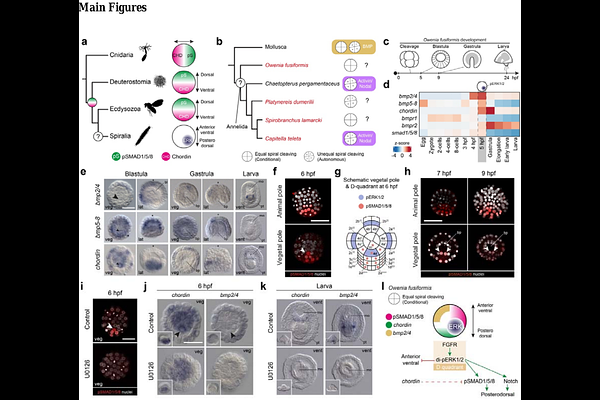Developmental system drift in dorsoventral patterning is linked to transitions to autonomous development in Annelida

Developmental system drift in dorsoventral patterning is linked to transitions to autonomous development in Annelida
Carrillo-Baltodano, A. M.; Haillot, E.; Meha, S. M.; Luqman, I.; Pashaj, A.; Lee, Y.-J.; Lu, T.-M.; Ferrier, D. E. K.; Schneider, S. Q.; Martin-Duran, J. M.
AbstractThe Bone Morphogenetic Protein (BMP) pathway is the ancestral signalling system defining the dorsoventral axis in bilaterally symmetrical animals. However, Spiralia, a large bilaterian clade including molluscs and annelids, uses the Fibroblast Growth Factor pathway and ERK1/2 as the ancestral cue to establish their posterodorsal side. How this profound change in axial patterning evolved and what it implied for BMP\'s developmental role remains elusive. Here, we studied four annelid species and combined disruption of the BMP and Activin/Nodal pathways with transcriptomics and blastomere deletions to demonstrate that BMP is ancestrally downstream of ERK1/2 and promotes dorsoventral development in Spiralia. Importantly, this signalling hierarchy is lost in annelids that secondarily transitioned into a maternally controlled, autonomous development. While some, like Capitella teleta, use Activin/Nodal, Platynereis dumerilii relies on BMP to establish dorsoventral polarity only in the head. Unexpectedly, this divergence in upstream axial regulators implied extensive rewiring of downstream targets, as inferred by comparing C. teleta and Owenia fusiformis. Our data clarify the ancestral axial role for BMP in Spiralia, unveiling a potential causal link between parallel shifts to autonomous cell-fate specification in early development and the emergence of developmental system drift, a pervasive yet poorly understood phenomenon in animal embryogenesis.